Mamas of Pokrovka Sarmatians
Preliminary results of mtDNA study
Molecular Archaeology
Institute for Anthropology
University of Mainz, Germany
| ALL PICTURES AND TEXT OF THIS REPORT OR ANY EXTRACTS FROM HERE ARE PROPERTY OF THE AUTHOR AND MAY NOT BE PUBLISHED WITHOUT HIS APPROVAL |
Abstracts related to the Turkic History
Links
http://www.csen.org/DNA_Report/DNA.html
- Repertory Warrior Women
http://en.wikipedia.org/wiki/Sarmatians
Foreword
So far only Pokrovka Sarmatian mamas from the unstated period between 6 c. B.C.-3 c. A.D. Papas promised later. The analysis of mamas tells us that either only most dedicated husbands dragged their sweethearts with them half a way across Eurasia, otherwise finding suitable spouses locally, or that only selected few women belonging to the local highest elite could get a ticket for a place under kurgan. Turkic Sredny Stog spreading east and west also fits the results and history nicely. Probably, we will hear many other speculations, none better than the other. The genetics must be a superbly touchy subject, since the report on Pokrovka innocent glass beads by Mark E. Hall and Leonid Yablonsky was published still in 19100. And the papas are still waiting their day under a sun, keeping the mystery alive and allowing proliferation of a kind of particular-type theories. Because Pokrovka is just one of many thousands kurgan burials, it allows only a pick into the history, statistically insignificant, and can be dismissed as an aberration in the whole picture of some particular-type theories. Much more honest research is needed.
Author's undefined yellow highlighting may indicate warrior burials, since one of the tasks of the study was to confirm that some of the buried warriors were in fact women. That was expected, though not completely appreciated by Indo-European-bent researchers. A real revelation of the study is the presence of the "surprising" - for the author, and probably for the same category of Indo-European researchers, which in itself is not surprising at all - the presence of a Turkic-rooted woman among the Pokrovka Sarmatians, and a complete absence of any pointers characteristic for the Indo-Iranians, who reputedly constituted a bulk, if not all, of the Sarmatians.
On a similar study in the Carpathian basin see comment “Early Neolithic’ graves of the Carpathian Basin are in fact 6000 years younger—Appeal for real interdisciplinarity between archaeology and ancient DNA research”, Journal of Human Genetics (2012) 00, 1–3, The Japan Society of Human Genetics, on the publication in the Journal of Human Genetics, vol. 56, issue 11 (15 November 2011), an article by Guba, Z. et al., and “Absence of the lactase-persistence-associated allele in early Neolithic Europeans”, Proc. Natl Acad. Sci. USA, 104, 3736–3741 (2007) by Burger, J. et al. So far (2012), the samples have not been retested, and results have not been published. Revisions are as cited below, 2 Sarmatian and 1 potentially Magyar or Bulgarian Kabar are of mtDnA Hg N9a.
| Specimen | Revised dating | Haplotype | Haplotype hg | Revised hg | (East) Asian hg | N9a distribution |
|---|---|---|---|---|---|---|
| Szarvas 23/22 | Sarmatian | 16261T 16291T 16293G 16304C | Novel | N? | Vietnam 0.78%, Kyrgyzstan 0.28%, China 0.23%, Kazakhstan 0.22%, Uzbekistan 0.21%, Thailand 0.14%, Buryatia 0.13% |
|
| Szarvas23/20 | Hung. Conq. p. | 16223T 16257A 16261T | N9a | N9a | + | |
| Szakmar–Kisules8 | Sarmatian | 16223T 16257A 16261T | N9a | N9a | + | |
| Csongrad–Bokros | Sarmatian | 16223T 16257A 16261T | N9a | N9a | + |
Summary of preliminary results of Sarmatian mtDNA study
Material and Methods
Specimen:
From Pokrovka 15 skeletons were examined.
Kurgan 7: 5 individuals - Burial of 1 man, 4 women and 2 children
Kurgan 8: 6 individuals - Burial of 2 men, 3 women, 1 child
Furthermore two mediaeval burials without exact date.
Extraction, PCR, cloning, sequencing
First test was done looking for old DNA. Then DNA had been isolated from all skeletons with Phenol Chloroform Extraction and concentration with Contricon 100.
PCR amplified the following marker:
1. mitochondrial DNA, Hypervariable Region 1 Position 15996 - 16410
= 415 bp
As fragments of 415 basic pairs on old DNA are not-expected, shorter
and overlapping fragments have been amplified (s. pict. 1)
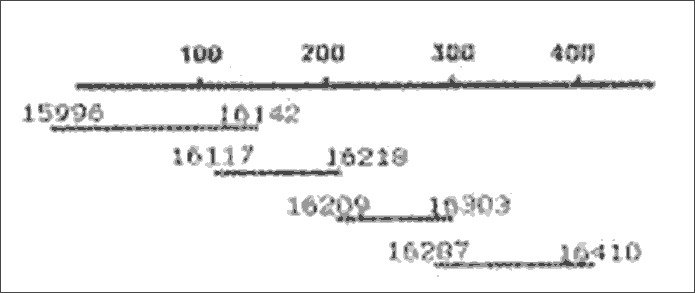
2. 9 short tandem repeat
loci
3. Amelogenin–locus (X-Y-Polymophismus)
All positive PCR products have been directly sequenced. In addition
single PCR products have been or are currently cloned (as of Apr. 12
2005).
6 - 10 clones
have been sequenced.
Control
With each extraction at least one extraction control has been
carried out. (blank or other species)
With each PCR at least one blind- control has been carried out.
All controls have been negative.
Condition of the material:
The amplified DNA showed the following, typical characteristics of
degraded DNA:
Few molecules
fragment longitude less then 200 base pairs
modified DNA molecules, particularly deamination of C ami G , bad
condition in general, eg, creation of secondary structures, slippage
at STRs
Reproduction
All DNA extractions have been carried out ternary and independently
(Ex A, B, C).
2 PCRS have been carried out of two extractions. (see graphic 2).
Graphic 2: reproduction Strategy
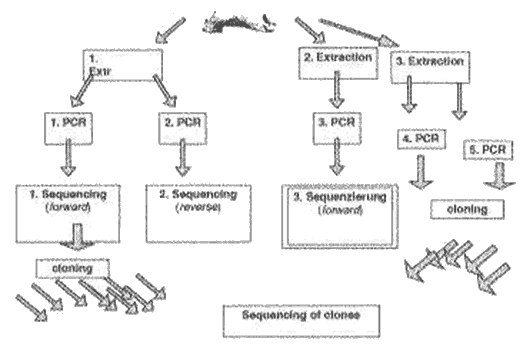
In conjunction with the STR Genotyping (generic fingerprint) the Amelogenin–locus has been analysed.
Results
| Sample | Amel | Sex |
| Pr 4 | X/Y | Male |
| Pr 5 | X | Female |
| Pr 6 | X | Female |
| Pr 3 | X/Y | Male |
| Pr 10 | X/Y | Male |
* more individuals are still being typed
Inter Tribal Relations:
12 out of 13 Sarmatian individuals have different mitochondrial DNA-Sequences. That means that the individuals are not maternally related; meaning no mothers related to daughters or sons, no siblings, no aunts no uncles from the mothers side, not related with cousins or cousins of the mothers sister, etc.
The only possible blood relation which could not be eliminated by the mt-DNA is the paternal relation. To review this possibility an STR-Genotype has been generated. This has been successfully done with 5 individuals so far (graphic 3).
| Probe | D3 S1358 |
D8 S1179 |
D5 S818 |
vWA | D21 S11 |
DI3 S317 |
FGA | D7 S820 |
D18 S5I |
Sex | Affiliation |
| Pr 4 | 15 | 12/14 | 12/13 | 18 | Male | W.Eurasia | |||||
| Pr 5 | 14 | 13 | 11 | Female | W.Eurasia | ||||||
| Pr 6 | 15/(17) | 8/10 | 10/13 | 17 | 28/ (32.2) | 11 | 22/24 | Female | Türkic | ||
| Pr 3 | 16 | 10/13 | 11 | (15) / 16 | 16 8/- 25 | Male | Undetermined | ||||
| Pr 10 | 16/17 | 11/12 | 10/12 | 14/18 | 29/30 | 8/12 | 22/23 | 11 | Male | Not yet |
According to the results of the five successfully analyzed individuals, none of these individuals is a first grade relative of any other individual (neither maternal nor paternal).
On all others, not yet positively - regarding STR - analyzed individuals, no comments can be made concerning paternal relations.
Ethnicity:
Mt-Sequences of 12 Sarmatians from the kurgan have been compared to 23.000 sequences from recessive populations (Data Base of Peter Poster, University of Cambridge). (recessive populations = homogeneous populations that because of their small size and interbreeding accumulate elevated proportion of recessive genes; that may result in visible peculiarities suppressed by dominant genes in non-recessive populations, such as predominantly light eyes - Translator's Note)
Graphic 4: Worldwide spreading of Haplotypes which are identical with Pr 11
Map details and comments are Translator's Notes
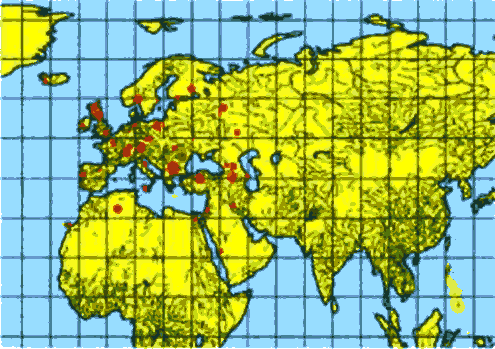 |
Enlarged map of Caucasus showing predominant location of Pr 11 type haplotypes in Turkic areas, Balkar/Karachai and Azeri in the Caucasus |
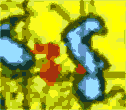 |
|
|
|
|
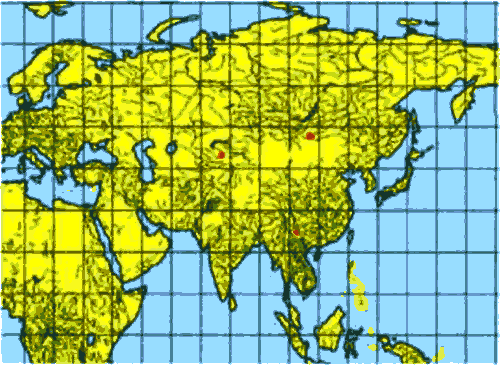 |
Enlarged map of Jeti-Su, a traditional location of Wusun/Usun, and current Uysyn people |
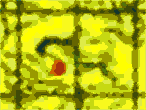 |
|
Enlarged map of Baikal and Noin-Ula area, center of Hun ancient state |
|
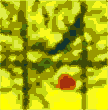 |
|
Location near the bend of Yantzi near Burma/Myanmar is a food for thought |
|
 |
|
The spreading of mt-DNA Hyplotypes in world-wide recessive populations can be divided in five groups:
1. Individuals with a Indo-European Haplotype with a geographical
spreading from Europe to Ural and the eastern parts of the
Mediterranean. All those Haplotypes accumulate within the Sarmatian
settlement area between the Black and Caspian Sea. (Pr 1, 4, 5,
8,11; graphic 4). Few samples were found in Africa but are not
significant and can be ascribed to the relatively young age of the
homo Sapiens.
2. One individual with only one equivalent in modern population,
namely in the Sarmatian settlement area between the Black See and
the Caspian Sea (Pr 13, Graphic 6)
3. Individuals with a Haplotype, which can not be clearly assigned
to a specific geographical area. (Pr 3, 15)
4. Individuals with a central-Asian respectively an east-Asian
Haplotype with a geographical extension from Kazakhstan to China (Pr
6; Graphic 5).
5. Individuals tending to Oriental/Arabic Haplotype (Pr 14).
Graphic 6: Worldwide spreading of Haplotypes which are identical with Pr 13
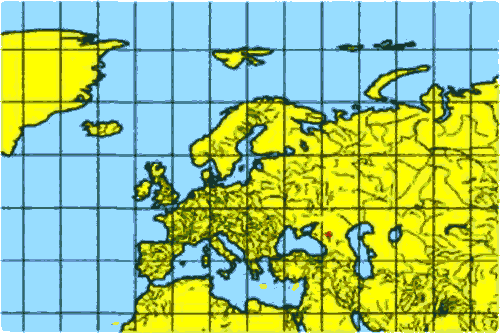 |
Enlarged map of Caucasus showing location of Pr 13 type haplotypes, also in Turkic area of Balkar/Karachai in the Caucasus |
 |
Pr 6 is the only sample that stands out from all other samples as it shows no Indo-European Haplotype at all. Surprisingly the smear tests of the oral mucosa of the women from western Mongolia complies with Pr 6 - except for one base.
A contamination of the material is not possible,
1. the recessive samples have been delivered after the bones have
been analyzed.
2. the samples differ in 1 base pairs (reproducible)
3. All three samples show a different STR-Profile
Resume:
1. The morphological gender determination is correct. The “warrior
women” are indeed female.
2. According to our results, the individuals from the kurgan are
neither maternally nor paternally related. Though the results on
paternal relation are not yet conclusive.
3. All individuals, who's origin can be derived from the mt-DNA
data, are of Indo-European origin (in old days, Indo-European used to be a
linguistic category. Now we can be genetically Indo-European. That's a rreal progress). Only Pr 6 has a
central-Asian/east- Asian Haplotype which is found among the Turkic
speaking nomadic people. This Haplotype is almost (one base pair
missing) identical with the Haplotype of the women from western
Mongolia.